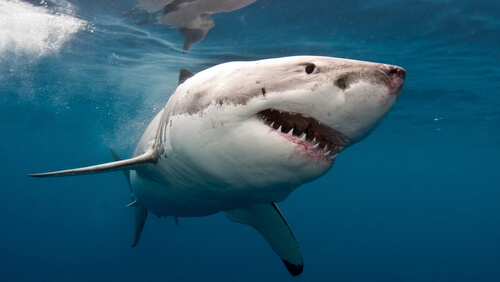
| Kingdom | Animalia |
| Phylum | Chordata |
| Class | Chondrichthyes |
| Order | Lamniformes |
| Family | Lamnidae |
| Genus | Carcharodon |
| Species | C. carcharias |
| Niche | Pelagic Predator |
| Length | Up to 20 ft (6.1 m) |
| Weight | 4,200-5,000 lb (1,905-2,268 kg) |
| Lifespan | 70+ years |
| Social Structure | Solitary |
| Conservation Status | Vulnerable |
| Preferred Habitat | Temperate Oceans |
| Average Litter Size | 2-10 pups |
| Main Prey Species | Seals, whales, fish, seabirds |
| Predators | Humans, orca |
The Basics
The great white shark is the only extant member of the genus Carcharodon and is a large, predatory species. Great white sharks are found in temperate oceans throughout the world and are known for their predatory prowess. Known as the ‘white shark’ in England and the ‘white pointer’ in Australia, the great white is one of the largest extant shark species, ranking behind only the whale shark and basking shark, both of which feed on much smaller prey than the great white shark.
Description
Great white sharks can grow to a total length of 20 feet and weigh as much as 5000 pounds. However, most individuals are smaller, with males being about 11-13 feet long and females typically 15-16 feet in length. They are robust but streamlined and have two triangular dorsal fins and large pectoral fins. Along with all other members of the order Carcharhiniformes, it also has an anal fin and five gill slits, along with a nictitating membrane over its eyes. The species is dimorphic, with females being larger than males by 3 ft (1 m) or more. Their skin ranges in color from blue-grey to light green with darker charcoal stripes on their sides and white undersides, reminiscent of the Great White Shark. The stripes of tiger sharks are usually more prominent on juvenile sharks than on adults.
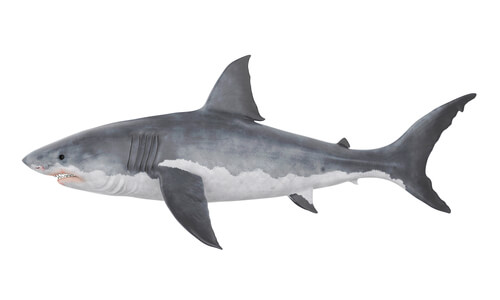
Distribution and Range
Great white sharks are pelagic animals, meaning they swim freely in the water column as opposed to living on the bottom. They can be found throughout most of the world’s temperate oceans, often in coastal areas where their prey are also more abundant. Individuals are often nomadic, often undertaking great migrations likely in search of food and mates. In one instance, a shark was tracked from South Africa to northwestern Australia and back in under nine months, a journey of more than 12,000 miles.
Predators and Prey
Great white sharks are largely solitary and often hunt at night, approaching reefs or channels in search of various food items. One of the most common prey items of great white sharks is marine mammals such as seals and sea lions. They will often breach the water’s surface in a high-speed pursuit of these species, sometimes clearing the surface by more than its own body length.
Great white sharks are also known to pursue other types of prey such as fish and sea birds. Although they are responsible for more attacks on humans than any other species, humans are not considered a natural prey item of the great white shark. Instead, these incidents are normally attributed to a case of mistaken identity. Sharks may often confuse humans with a relatively similarly-shaped seal or sea lion. Great white sharks will also feed on other sharks, including younger members of their own species.
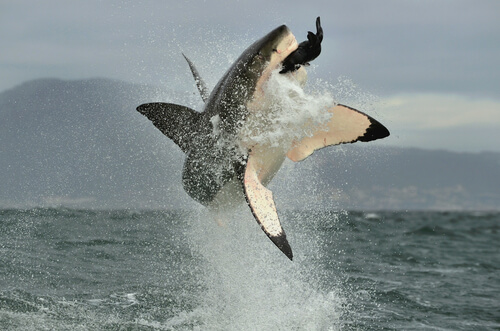
The great white shark has few natural predators but is sometimes attacked by groups of orcas that will use their size advantage and complex social structure to overtake them. This is believed to be rare. They are also common victims of illegal fishing practices such as shark finning. Combined with the destruction of natural marine habitats around the world due to pollution and destructive fishing techniques, the great white shark is listed as “Vulnerable” on the IUCN Red List of Threatened Species.
Reproduction
Male great white sharks may take more than twenty-five years to reach sexual maturity while females, who grow bigger than males in general, reach sexual maturity at about thirty-three years of age. Little is known about the species’ mating habits, with mating behavior having never been observed until 1997. It is believed that males and females will lay belly-to-belly, rolling repeatedly during copulation.
The birth of a great white shark has never been observed. However, the examination of pregnant females has revealed that they are ovoviviparous. This means that their eggs will hatch internally and continue to develop within the uterus before giving birth to the pups following an 11-month gestation period. The most pups ever attributed to one female is fourteen. The new pups’ powerful jaws will begin to develop within their first month, and they are mostly independent from birth.
Are They Dangerous?
The great white shark has killed more humans than any other species of shark. That being said, humans are not a natural prey item of the species. Like most fatal shark attacks, encounters are normally the result of the shark taking an interest in the person, and attempting a ‘test bite’ to determine what it is. Most sharks lose interest and swim away, but unfortunately, the resulting injuries can be fatal. Because great white sharks prey so heavily on species such as seals, it is believed that they often mistake humans for seals or sea lions and only realize they are mistaken once a test-bite has been taken. However, armed with so many sharp, serrated teeth, this often results in massive injuries to the person and can often be fatal.
Fun Facts about the Great White Shark!
From their heightened predatory senses to their massive size, great white sharks are the most infamous shark species in the world. It’s not without unique and advantageous adaptations that it came to be such a dominant predatory force throughout the oceans of the world.
The Force of Nature
The power and ferocity of the great white shark have long fascinated researchers and seafarers. One obvious question is how powerful are its jaws? In 2007, researchers in Australia attempted to answer this question. Using CT scans of a shark’s skull in combination with computer modelling, researches at the University of New South Wales in Sydney, Australia were able to measure the species’ maximum bite force. This was followed by another study in 2008 that determined an individual shark weighing 7,328 pounds was able to exert a bite force of 18,216 newtons. Although very powerful, this is not particularly disproportionate for their body mass.
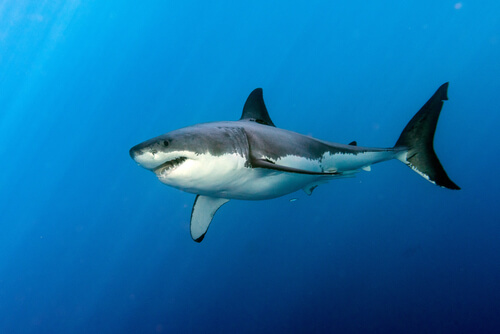
Deeper, Faster, Longer
The great white shark is well-evolved for hunting large, swift prey such as sea lions and seals. Despite their massive size, they are impressively agile and can swim very quickly. Indeed, they can reach speeds of more than 16 mph in short bursts, normally while in pursuit of prey.
They also undertake lengthy migrations during which time they have been observed diving very deep, often reaching depths of nearly 4,000 feet. It is somewhat unclear why they undertake these deep dives, although it may be in search of prey such as squid and other deep-dwelling species. However, there is a trade-off to be made by the shark here as these dives may be energetically costly.
During their long migrations, great whites rely on fats and oils stored within their livers to survive with little to no food as they cross relatively unproductive parts of the oceans. These fats and oils can help them remain more buoyant, presumably reducing the amount of energy required to swim these long distances. Also, in individuals that dive to deep depths more quickly than others, it was observed that they use up these energy stores more quickly than those that sink at a more leisurely rate. This supports the theory that there exists some sort of trade-off between preserving these important energy stores and reaching deeper waters quickly, perhaps to access new prey as soon as possible.
A Unique Weapon
In addition to its speed and power, the great white shark is also equipped with further special weapons that allow it to be one of the most effective predators in the sea. Its genus, Carcharodon, translates as ‘jagged tooth’ in reference to the large serrations along the edges of the shark’s already massive and sharp teeth. These serrations allow the shark to quickly eviscerate its prey and to shred the thick skin present in species like seals and sea lions, making consuming its victims a quicker, less labor-intensive process than it would be otherwise. Indeed, it was these serrations that originally led to the great white shark being classified as a descendant of mega-toothed shark species such as the prehistoric Megalodon.
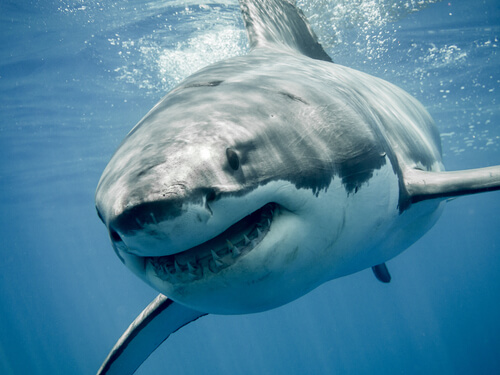
However, more recent evidence suggests that the great white is more closely related to mako sharks and is descended from a separate lineage from the mega-toothed sharks. This connection was made when a fossil of an intermediate transitional species called Carcharodon hubbelli connected the great white to an unserrated shark species known as Carcharodon hastalis. This discovery led to the current theory that serrations evolved between 8 to 5 million years ago and represent a shifting diet and a change of niches occupied by these species. Indeed, these serrations likely evolved specifically to aid in the hunting of marine mammals such as seals.
